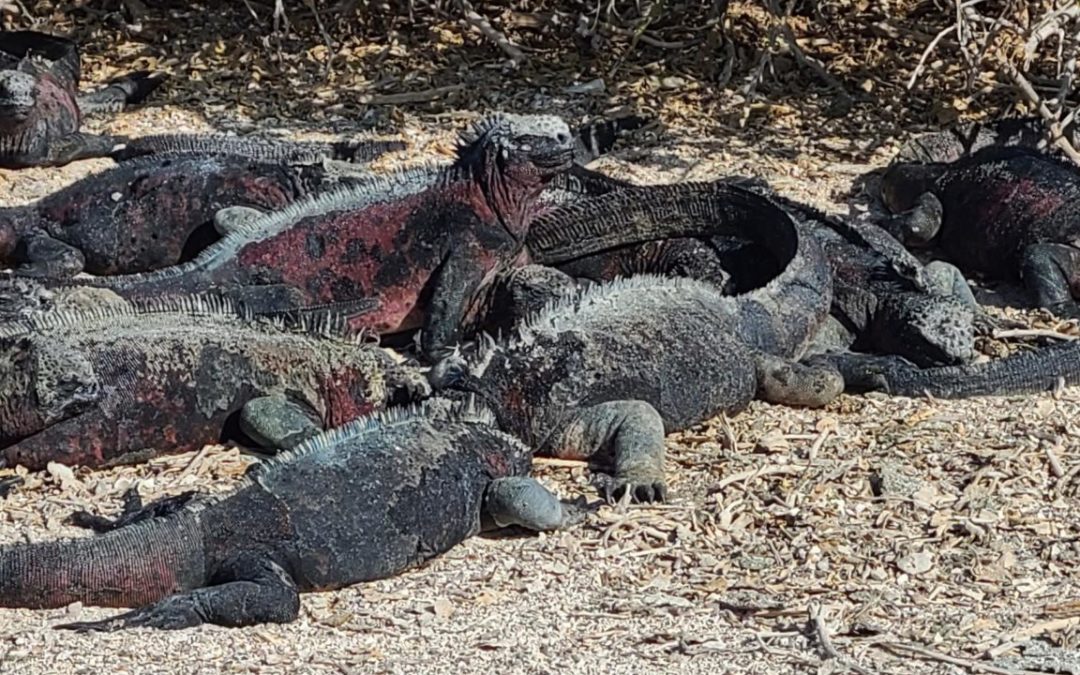The first animals we saw in the Galapagos were the up close bright orange crabs and sea lions, but I had gone hoping to see blue-footed boobies, Galapagos tortoises, marine iguanas, and perhaps if I was lucky a Galapagos hawk.
The sea lions and crabs seemed to be on every island, but so were the marine iguanas. The marine iguana is the only sea lizard. In the whole world, it is the only lizard to live and forage at sea. And it only lives in the Galapagos Archipelago.
Marine iguanas arrived on the island as land iguanas, but there wasn’t enough food to eat. Over time, they adapted to eating the algae that were growing in the salt water. Even more time and they evolved into different species. Scientists used to think there were only five to seven species but now believe there are eleven very similar species or subspecies. These are found on different islands. The northern islands have the largest species.
Generally, marine iguanas are dark to soak up the most amount of heat from the sun. During breeding season (January to March), the males (typically larger than the females) become brighter and more colorful. Near the islands of Española and Floreana, they are bright green and red. On Santa Cruz island, they are red and black. On Fernandina, they become dull green and brick red. During the mating season, males fight for dominance over harems of females, which they will fiercely defend from rival males.
On land, they are not very agile. In the ocean, they are excellent swimmers. They move through the waves to feed on the ocean algae. Larger individuals go out further, even into the strong currents. Smaller marine iguanas stay near rock pools and eat at low tide.
Eating sea vegetation comes with extra salt content. Both land and marine iguanas have a salt gland in their nostrils to excrete extra salt from their bodies. Marine iguanas have perfected the excretion of salt over their terrestrial cousins. In the exam rooms, I see iguanas spit salt up to four inches. We saw marine iguanas ‘spit’ salt a couple of feet.
Snorkeling off the Galapagos was not like other places I had snorkeled. The powerful Humboldt and other currents made staying somewhere and getting somewhere difficult. One place we were dropped off in the current around rocks, and I’m pretty sure I swallowed and inhaled half of the Humboldt current before requesting pick up from the Zodiac. Marine iguanas are powerful swimmers and use their flat tails to help them swim. Powerful claws grip the rocks to allow them to feed.
Iguanas are not really social, but we would see large groups. They would group together, all facing the sun, to conserve heat. Mornings would be spent basking in the sun to raise their temperatures to get enough energy to swim in the colder seas to eat. In the water, their heartbeat can slow by fifty percent to conserve energy. In the presence of sharks, they may be able to stop it entirely for up to 45 minutes to avoid being seen.
We did also see land iguanas. Their behavior was very different. They were higher in the grassy areas with burrows dug back in 3 to 6 feet. They were more solitary and much larger. Cousins of the land iguana are the ones that have entered the pet trade. Their need for heat and light is critical and why we see few that are truly healthy.
The only predator on the islands has historically been the Galapagos hawk. So unless you blocked the sun, they would not move. The black iguanas blended in with the lava rocks to the point that folks would pass back “iguana in the trail” so that we didn’t accidentally step on them. Unfortunately, dogs and cats that have been introduced to the island have affected populations of marine iguanas. We did see a cat on a rocky oceanside cliff. The cat was drinking salt water and the guide said that the cats were adapted to do that. We, veterinarians, were skeptical and proposed a study. More likely, the cats live a decreased life span, but due to their reproductive rates they still eat a lot of juvenile marine iguanas. Dogs could take out an adult marine iguana for food or sport.
Another thing that affects the marine iguana population is El Nino. El Niño is a climate pattern that happens every 5 to 7 years. The unusual warming of surface waters in the eastern tropical Pacific Ocean affects the currents that bring nutrient-rich water for the algae. It also cuts short the plankton that fish and clams eat. Microplastics also threaten the marine iguanas.
We saw marine iguanas on all of the islands, but they were not afraid, and we could get close. The amazing thing about all of the animals on the Galapagos is that they grew up without land predators. This means that they were not afraid. You could walk right up to them. They have a six-foot rule that you are not allowed to be closer than six feet to the animals. That is for the protection of the animals, not the humans. In fact, when coming out of the ocean from snorkeling, I was having trouble with the surf, shells, and standing because of my bad knee. By the time I had navigated these issues and was standing, I was about to step on a pair of sea lions, the mom and a teenager. I looked up as I was less than three feet from the pair and asked our guide why he didn’t remind me about the six-foot rule and he said I was about to find out about it.

